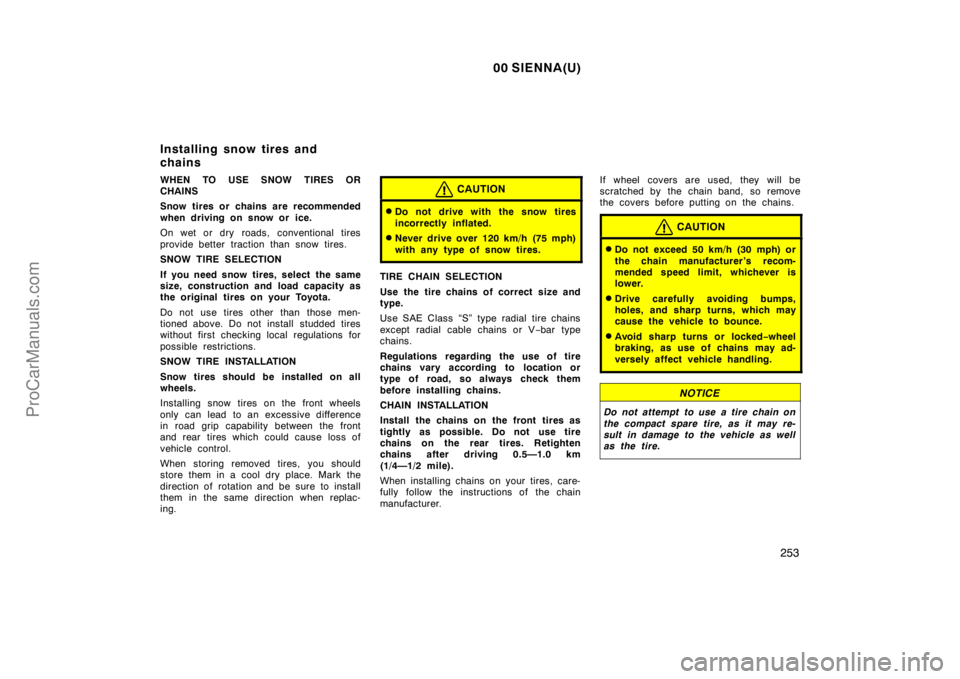Page 258 of 282

00 SIENNA(U)
252
Initial adjustment of the tire pressure
warning system is necessary after you
have replaced your tires. See ”Tire
pressure warning system” in Section
1−8.
Rotating tires
Steel wheels with a compact spare tire
and aluminum wheels
Steel wheels without a compact spare tire
To equalize the wear and help extend
tire life, Toyota recommends that you
rotate your tires approximately every
12000 km (7500 miles). However, the
most appropriate timing for tire rotation
may vary according to your driving hab-
its and road surface conditions.
See “If you have a flat tire” in Section 4
for tire change procedure.
When rotating tires, check for uneven
wear and damage. Abnormal wear is usu-
ally caused by incorrect tire pressure, im-
proper wheel alignment, out−of−balance
wheels, or severe braking.
CAUTION
Do not include a compact spare tire
when rotating the tires. It is designed
for temporary use only.
Initial adjustment of the tire pressure
warning system is necessary after you
have rotated your tires. See ”Tire pres-
sure warning system” in Section 1−8.
ProCarManuals.com
Page 259 of 282

00 SIENNA(U)
253
WHEN TO USE SNOW TIRES OR
CHAINS
Snow tires or chains are recommended
when driving on snow or ice.
On wet or dry roads, conventional tires
provide better traction than snow tires.
SNOW TIRE SELECTION
If you need snow tires, select the same
size, construction and load capacity as
the original tires on your Toyota.
Do not use tires other than those men-
tioned above. Do not install studded tires
without first checking local regulations for
possible restrictions.
SNOW TIRE INSTALLATION
Snow tires should be installed on all
wheels.
Installing snow tires on the front wheels
only can lead to an excessive difference
in road grip capability between the front
and rear tires which could cause loss of
vehicle control.
When storing removed tires, you should
store them in a cool dry place. Mark the
direction of rotation and be sure to install
them in the same direction when replac-
ing.CAUTION
�Do not drive with the snow tires
incorrectly inflated.
�Never drive over 120 km/h (75 mph)
with any type of snow tires.
TIRE CHAIN SELECTION
Use the tire chains of correct size and
type.
Use SAE Class “S” type radial tire chains
except radial cable chains or V−bar type
chains.
Regulations regarding the use of tire
chains vary according to location or
type of road, so always check them
before installing chains.
CHAIN INSTALLATION
Install the chains on the front tires as
tightly as possible. Do not use tire
chains on the rear tires. Retighten
chains after driving 0.5—1.0 km
(1/4—1/2 mile).
When installing chains on your tires, care-
fully follow the instructions of the chain
manufacturer.If wheel covers are used, they will be
scratched by the chain band, so remove
the covers before putting on the chains.
CAUTION
�Do not exceed 50 km/h (30 mph) or
the chain manufacturer ’s recom-
mended speed limit, whichever is
lower.
�Drive carefully avoiding bumps,
holes, and sharp turns, which may
cause the vehicle to bounce.
�Avoid sharp turns or locked−wheel
braking, as use of chains may ad-
versely affect vehicle handling.
NOTICE
Do not attempt to use a tire chain on
the compact spare tire, as it may re-
sult in damage to the vehicle as well
as the tire.
Installing snow tires and
chains
ProCarManuals.com
Page 275 of 282
00 SIENNA(U)
269
Tires
Tire sizeTire pressure,
kPa (kgf/cm2 or bar, psi)Wheel size
P205/70R15 95S 240 (2.4, 35) 15�6.5JJ
220 (2.2, 32)
∗
1
240 (2.4, 35)∗
2
T145/80D16 420 (4.2, 60)
15�6.5JJ
16�4T P215/65R15 95S Normal driving
Trailer towing
Tire sizeTire pressure,
kPa (kgf/cm
2 or bar, psi)Wheel size
P205/70R15 95S 240 (2.4, 35) 15�6.5JJ
240 (2.4, 35)
15�6.5JJ P215/65R15 95S
When driving under the above vehicle load conditions at sustained high
speeds above 160 km/h (100 mph), in countries where such speeds are
permitted by−law, inflate the front and rear tires to 240 kPa (2.4 kgf/cm
2
or bar, 35 psi) provided that it does not exceed the maximum cold tire
pressure molded on the tire sidewall. Tire size and pressure:
∗
1: Vehicle load up to 6 passengers∗
2: Up to vehicle capacity weightWheel nut torque, N·m (kgf·m, ft·lbf):
104 (10.5, 77)
ProCarManuals.com
Page 281 of 282

00 SIENNA(U)
275
Traction AA, A, B, C—The traction
grades, from highest to lowest, are AA, A,
B, and C, and they represent the tire’s
ability to stop on wet pavement as mea-
sured under controlled conditions on spe-
cified government test surfaces of asphalt
and concrete. A tire marked C may have
poor traction performance.
Warning: The traction grade assigned to
this tire is based on braking (straight
ahead) traction tests and does not include
cornering (turning) traction.
Temperature A, B, C—The temperature
grades are A (the highest), B, and C,
representing the tire’s resistance to the
generation of heat and its ability to dissi-
pate heat when tested under controlled
conditions on a specified indoor laboratory
test wheel. Sustained high temperature
can cause the material of the tire to de-
generate and reduce tire life, and exces-
sive temperature can lead to sudden tire
failure. The grade C corresponds to a lev-
el of performance which all passenger car
tires must meet under the Federal Motor
Vehicle Safety Standard No.109. Grades B
and A represent higher levels of perfor-
mance on the laboratory test wheel than
the minimum required by law.Warning: The temperature grades for this
tire are established for a tire that is prop-
erly inflated and not overloaded. Exces-
sive speed, underinflation, or excessive
loading, either separately or in combina-
tion, can cause heat buildup and possible
tire failure.
ProCarManuals.com
Page:
< prev 1-8 9-16 17-24